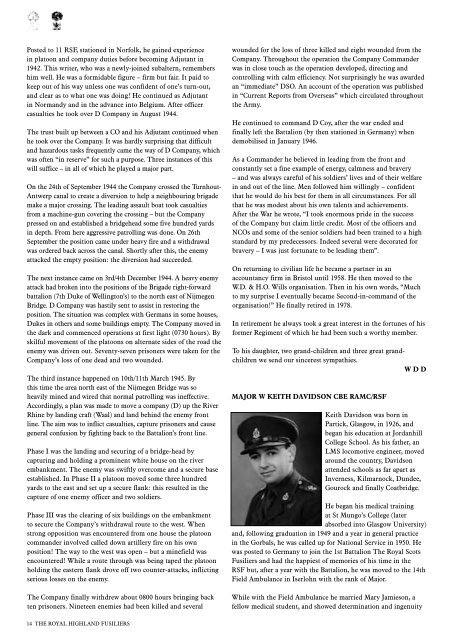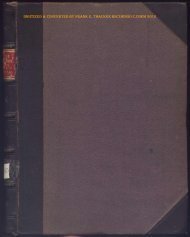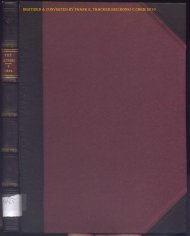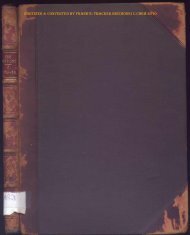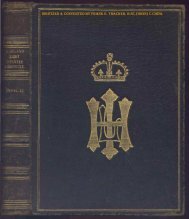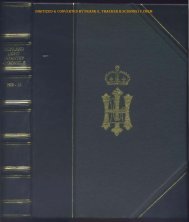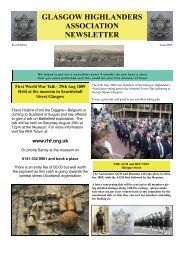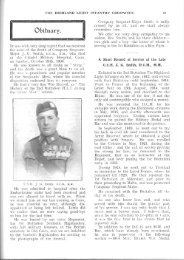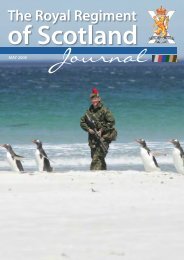Journal 2008 - The Journal Royal Highland Fusiliers - The Royal ...
Journal 2008 - The Journal Royal Highland Fusiliers - The Royal ...
Journal 2008 - The Journal Royal Highland Fusiliers - The Royal ...
You also want an ePaper? Increase the reach of your titles
YUMPU automatically turns print PDFs into web optimized ePapers that Google loves.
Posted to 11 RSF, stationed in Norfolk, he gained experiencein platoon and company duties before becoming Adjutant in1942. This writer, who was a newly-joined subaltern, remembershim well. He was a formidable figure – firm but fair. It paid tokeep out of his way unless one was confident of one’s turn-out,and clear as to what one was doing! He continued as Adjutantin Normandy and in the advance into Belgium. After officercasualties he took over D Company in August 1944.<strong>The</strong> trust built up between a CO and his Adjutant continued whenhe took over the Company. It was hardly surprising that difficultand hazardous tasks frequently came the way of D Company, whichwas often “in reserve” for such a purpose. Three instances of thiswill suffice – in all of which he played a major part.On the 24th of September 1944 the Company crossed the Turnhout-Antwerp canal to create a diversion to help a neighbouring brigademake a major crossing. <strong>The</strong> leading assault boat took casualtiesfrom a machine-gun covering the crossing – but the Companypressed on and established a bridgehead some five hundred yardsin depth. From here aggressive patrolling was done. On 26thSeptember the position came under heavy fire and a withdrawalwas ordered back across the canal. Shortly after this, the enemyattacked the empty position: the diversion had succeeded.<strong>The</strong> next instance came on 3rd/4th December 1944. A heavy enemyattack had broken into the positions of the Brigade right-forwardbattalion (7th Duke of Wellington’s) to the north east of NijmegenBridge. D Company was hastily sent to assist in restoring theposition. <strong>The</strong> situation was complex with Germans in some houses,Dukes in others and some buildings empty. <strong>The</strong> Company moved inthe dark and commenced operations at first light (0730 hours). Byskilful movement of the platoons on alternate sides of the road theenemy was driven out. Seventy-seven prisoners were taken for theCompany’s loss of one dead and two wounded.<strong>The</strong> third instance happened on 10th/11th March 1945. Bythis time the area north east of the Nijmegen Bridge was soheavily mined and wired that normal patrolling was ineffective.Accordingly, a plan was made to move a company (D) up the RiverRhine by landing craft (Waal) and land behind the enemy frontline. <strong>The</strong> aim was to inflict casualties, capture prisoners and causegeneral confusion by fighting back to the Battalion’s front line.Phase I was the landing and securing of a bridge-head bycapturing and holding a prominent white house on the riverembankment. <strong>The</strong> enemy was swiftly overcome and a secure baseestablished. In Phase II a platoon moved some three hundredyards to the east and set up a secure flank: this resulted in thecapture of one enemy officer and two soldiers.Phase III was the clearing of six buildings on the embankmentto secure the Company’s withdrawal route to the west. Whenstrong opposition was encountered from one house the platooncommander involved called down artillery fire on his ownposition! <strong>The</strong> way to the west was open – but a minefield wasencountered! While a route through was being taped the platoonholding the eastern flank drove off two counter-attacks, inflictingserious losses on the enemy.<strong>The</strong> Company finally withdrew about 0800 hours bringing backten prisoners. Nineteen enemies had been killed and severalwounded for the loss of three killed and eight wounded from theCompany. Throughout the operation the Company Commanderwas in close touch as the operation developed, directing andcontrolling with calm efficiency. Not surprisingly he was awardedan “immediate” DSO. An account of the operation was publishedin “Current Reports from Overseas” which circulated throughoutthe Army.He continued to command D Coy, after the war ended andfinally left the Battalion (by then stationed in Germany) whendemobilised in January 1946.As a Commander he believed in leading from the front andconstantly set a fine example of energy, calmness and bravery– and was always careful of his soldiers’ lives and of their welfarein and out of the line. Men followed him willingly – confidentthat he would do his best for them in all circumstances. For allthat he was modest about his own talents and achievements.After the War he wrote, “I took enormous pride in the successof the Company but claim little credit. Most of the officers andNCOs and some of the senior soldiers had been trained to a highstandard by my predecessors. Indeed several were decorated forbravery – I was just fortunate to be leading them”.On returning to civilian life he became a partner in anaccountancy firm in Bristol until 1958. He then moved to theW.D. & H.O. Wills organisation. <strong>The</strong>n in his own words, “Muchto my surprise I eventually became Second-in-command of theorganisation!” He finally retired in 1978.In retirement he always took a great interest in the fortunes of hisformer Regiment of which he had been such a worthy member.To his daughter, two grand-children and three great grandchildrenwe send our sincerest sympathies.W D DMAJOR W KEITH DAVIDSON CBE RAMC/RSFKeith Davidson was born inPartick, Glasgow, in 1926, andbegan his education at JordanhillCollege School. As his father, anLMS locomotive engineer, movedaround the country, Davidsonattended schools as far apart asInverness, Kilmarnock, Dundee,Gourock and finally Coatbridge.He began his medical trainingat St Mungo’s College (laterabsorbed into Glasgow University)and, following graduation in 1949 and a year in general practicein the Gorbals, he was called up for National Service in 1950. Hewas posted to Germany to join the 1st Battalion <strong>The</strong> <strong>Royal</strong> Scots<strong>Fusiliers</strong> and had the happiest of memories of his time in theRSF but, after a year with the Battalion, he was moved to the 14thField Ambulance in Iserlohn with the rank of Major.While with the Field Ambulance he married Mary Jamieson, afellow medical student, and showed determination and ingenuity14 THE ROYAL HIGHLAND FUSILIERS


